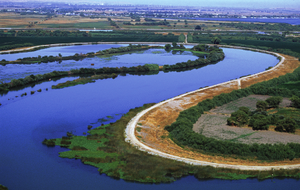WaterWater scarcity in California's Bay-Delta necessitates “hard decisions”
Simultaneously attaining a reliable water supply for California and protecting and rehabilitating its Bay-Delta ecosystem cannot be realized until better planning can identify how trade-offs between these two goals will be managed when water is limited

California's Bay-Delta water supply area // Source: usgs.gov
Simultaneously attaining a reliable water supply for California and protecting and rehabilitating its Bay-Delta ecosystem cannot be realized until better planning can identify how trade-offs between these two goals will be managed when water is limited, says a new report from the National Research Council. Recent efforts have been ineffective in meeting these goals because management is distributed among many agencies and organizations, which hinders development and implementation of an integrated, comprehensive plan. Additionally, it is impossible to restore the delta habitat to its pre-disturbance state because of the extensive physical and ecological changes that have already taken place and are still occurring, including those due to multiple environmental stressors.
A national Academy of Sciences release reports that the delta region receives fresh water from the Sacramento and San Joaquin rivers and their tributaries, and ultimately flows into San Francisco Bay and the Pacific Ocean. Water-pumping stations divert water from the delta, primarily to supply Central Valley agriculture and metropolitan areas in southern California, the Bay Area, and the delta itself. An increasing population and the operation of the engineered water-control system have substantially altered the delta ecosystem, including its fish species. Conflicts among various water users have grown, and there are sharp differences of opinion concerning the timing and amount of water that can be diverted from the delta for agricultural, municipal, and industrial purposes and how much water, and of what quality, is needed to protect the delta ecosystem. The U.S. departments of the Interior and Commerce asked the Research Council to identify the factors affecting fish species in the delta, review future water supply and delivery options, determine gaps in knowledge, and advise on the degree of delta restoration that is attainable while maintaining both an environmentally sustainable ecosystem and a reliable water supply.
It is likely that water scarcity in the delta will become increasingly severe, the report says.
Failure to acknowledge this problem and craft plans and policies that address water scarcity for all needs has made delta water management more difficult than is necessary. The committee that wrote the report suggested establishing priorities for water use, accounting for trade-offs in decision making, optimizing the availability of existing water supplies, enforcing California’s constitutional prohibition against non-beneficial and wasteful water use, and practicing water conservation, among other principles and guidelines.
Multiple environmental stressors — such as dams; water pumping stations; introduced and invasive species; and changes in nitrogen and
